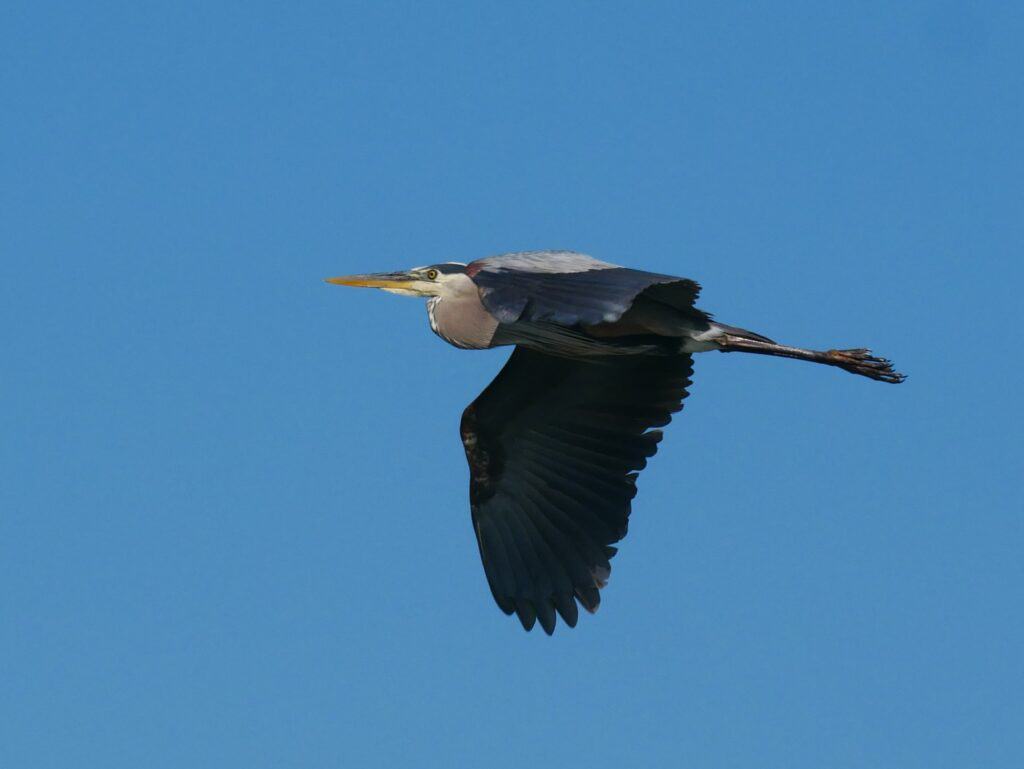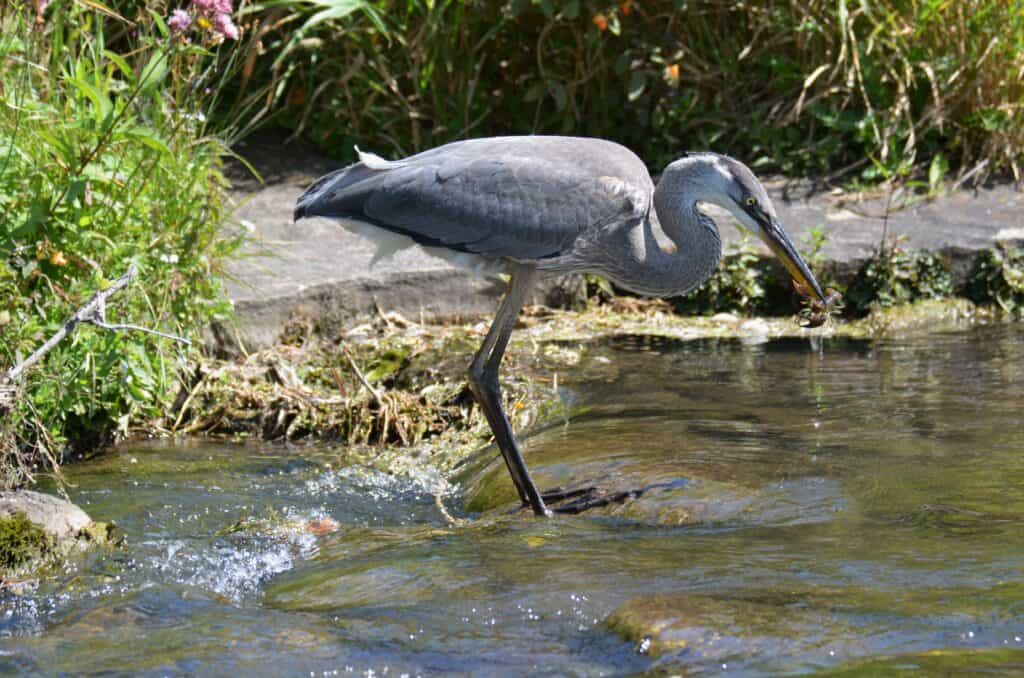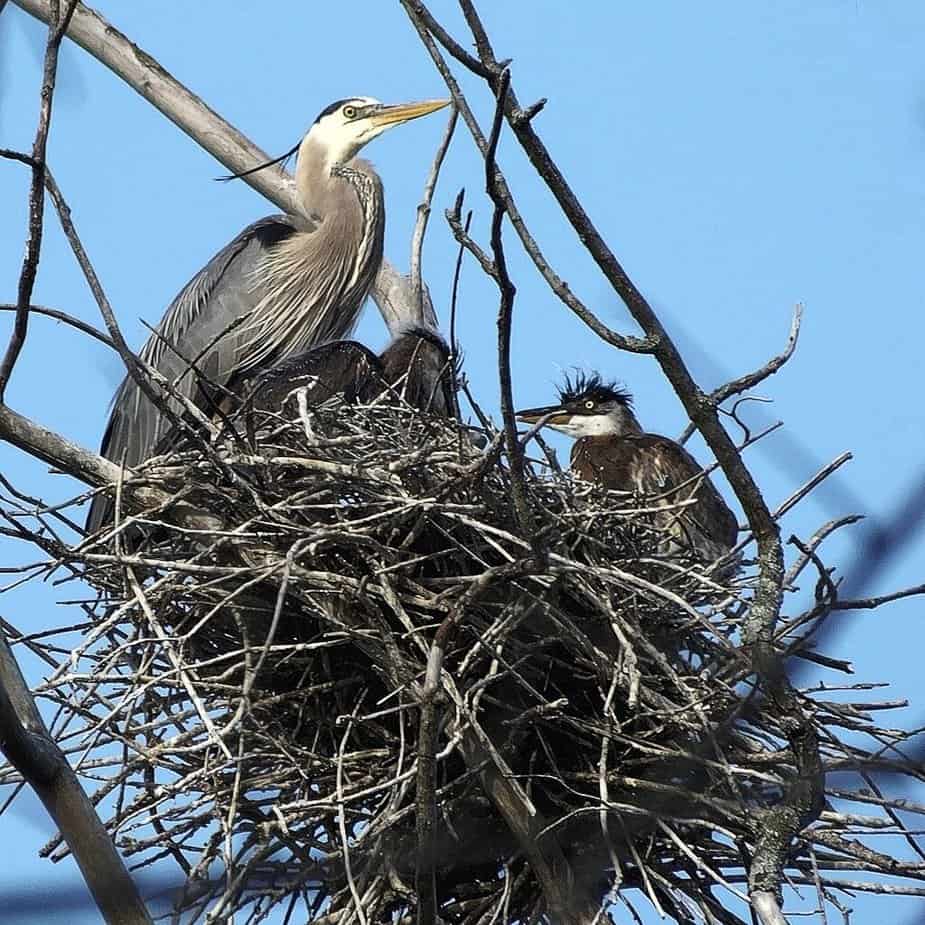Peterborough’s new official bird offers much to teach us
Peterborough Examiner – October 7, 2022 – by Drew Monkman
Standing motionless in Jackson Creek or cruising slowly over the Otonabee River with its silent, deep wingbeats, there a few sights in nature more majestic than a great blue heron. Add the beauty of its subtle, blue-gray plumage and its familiarity to most people and you have an excellent choice for Peterborough’s new official bird.
The decision was recently announced by Bird Friendly Peterborough who organized the vote by local residents. Last spring, Peterborough qualified at an entry level as a Bird Friendly City, meeting criteria set by Nature Canada. The designation tells the world that a city like Peterborough is taking action to reverse bird declines by reducing risk factors, improving and protecting habitat, and promoting awareness and education. Choosing an official bird is an integral part of this process.

A great choice
There’s a host of reasons why the great blue heron is an excellent selection. Although herons are relatively common, it’s always exciting to see one. Their impressive size and powerful flight never cease to impress. They’re also long-lived birds, sometimes more than 20 years.
Great blue herons are easy to identify, even in flight. Unlike the somewhat similar sandhill crane that flies with its neck fully stretched out – and usually in small groups – the heron’s neck is doubled back with the head resting against the shoulders. The increasingly common great egret looks similar to the heron in flight but is all white.
The heron also personifies silence – something I prize in our noise-filled modern world – in its slow, methodical flight and as it waits motionless for minutes at a time before catching its prey. As one poet wrote, a heron standing almost frozen in place seems to have no other preoccupation in the world than letting time flow gently between its legs.
In his book “Lumière des oiseaux”, Pierre Morency captures the essence of this bird. “The great blue heron is the bird philosopher. It possesses the seriousness and calm of those who make a habit of seeing clearly and scrutinizing below the surface of things. It’s a bird whose contemplation leads us to reflect on the passage of time itself, by evoking the two contradictory and complementary aspects of time: slowness, quasi-immobility, followed, sometimes on the drop of a dime, by dizzying rapidity.”
Herons can be found in most any type of wetland habitat, from small ponds and marshes to the shores of lakes and rivers. I often see one in the early morning flying along the shoreline at my brother’s cottage, its slow, silent wing beats complementing the quiet dawn.
Among the many spots where they turn up in Peterborough, the Otonabee River south of the zoo and the big pond in Jackson Park are always worth checking. The north shore of Rice Lake is another location where you’re likely to see them, particularly in the vicinity of Hiawatha and at the bottom of Drummond Line.

Migration
Herons are migratory birds and prodigious, long-distance flyers. In fall, they migrate south into the U.S., Mexico, Central America, and the Caribbean. One great blue heron that was captured in Maine and fitted with a GPS tracker flew non-stop for 40 hours to Bermuda. It hung out there for three days, before embarking on a 30-hour flight to the Bahamas. Its final destination ended up being Cuba. Who knows? Maybe some of our local herons make it to these exotic over-wintering locales, as well. Their migration reminds us that bird conservation needs to focus as much on wintering habitat as on protecting the habitat where they nest.
Great blue herons return to their nesting colonies in the Kawarthas each year in late March. You can sometimes see them standing on the ice at Little Lake. Fall migration begins in September, but small numbers usually remain until early December. There are also a few winter records.
Feeding
Herons stalk their prey by quietly walking through shallow water and waiting motionless for fish, frogs, crayfish, and other aquatic animals to swim close by. Sometimes, they’ll also hunt on lawns and in fields for small animals like voles, chipmunks and even grasshoppers.
The shape of the neck is key in the heron’s hunting success. A modification of one of the vertebrae lets it draw the neck into an S-shape, creating a coil in the bones that allows the bird to strike at prey with incredible speed.
When they catch a fish, they swallow it whole and always headfirst. In this way it slides down their throat smoothly and the scales don’t scrape the delicate throat tissues. If herons have young to feed, they regurgitate the food onto the nest floor for the babies’ dining pleasure.
Nesting
With the odd exception, great blue herons are colonial nesters, often building their bulky, stick nests where tall trees are located in standing water. Nesting in a colony permits cooperative protection from predators such as raccoons, eagles, and great horned owls. Individuals also learn from each other about the location of food resources.
Elaborate courtship rituals help the male and female form strong bonds. These include a ritualized greeting, bill snapping, transferring sticks, and crest raising. They also make a squawking “roh-roh-roh” landing call when they arrive at the nest. Both sexes incubate the eggs and feed the young.
There are several heron colonies in or near Peterborough. A small number of active nests can be seen at the Trent Wildlife Sanctuary in a swamp to the east of the northeast corner of the Blue Trail. A woman told me several years ago of her exciting experience at this heronry during a very heavy June downpour. She described a feeding frenzy with four different adults returning to their respective nests and feeding their offspring amidst torrential rain, thunder and lightning.
A much larger heronry with more than a hundred nests is located in the woods at the bottom of Drummond Line, near Hiawatha. How many nests are still active, I don’t know. A nearby resident, Richard Peachy, is concerned by a marked decrease in the number of heron “overflights” he saw this summer. “It could be, I hope, that the hunting grounds of the heronry have shifted south and our route is just not as productive as previously, but this trend doesn’t bode well,” he told me.

Climate and conservation
The most recent Atlas of the Breeding Birds of Ontario (2001-2005) showed a significant 22% decline in heron numbers in the Southern Shield region, just to the north of Peterborough. Why this is happening is not certain. At the very least,
herons should remind us of the importance of protecting wetland habitat. Many heron populations have been affected by wetland drainage associated with development and agricultural expansion. Wetlands, of course, store vast amounts of carbon and act as sponges in the heavy precipitation events associated with climate change.
As Otonabee Ward Coun. Kim Zippel said at the official bird announcement ceremony, “When we make the environment friendly for birds, we make it friendly for people; it’s all connected.”
CLIMATE CHAOS UPDATE
Vote for the climate! The most important individual climate action you can take right now is to vote with climate top of mind in the October 24 municipal election. Internet voting starts October 1. To learn how sitting Peterborough councillors voted on climate-related issues and where current candidates in the City and in Peterborough County stand (as based on a questionnaire they received), go to https://forourgrandchildren.ca/2022-municipal-election/ As you will see, not all of the candidates deemed this issue important enough to take the time to complete the survey.
Carbon dioxide: The atmospheric CO2 reading for the week ending October 9 was 415.51 parts per million (ppm), compared to 413.84 ppm a year ago. Rising CO2 means more climate catastrophes ahead.